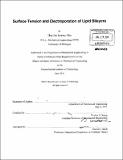Surface tension and electroporation of lipid bilayers
Author(s)
Cho, Han-Jae Jeremy
DownloadFull printable version (12.42Mb)
Other Contributors
Massachusetts Institute of Technology. Dept. of Mechanical Engineering.
Advisor
Evelyn N. Wang.
Terms of use
Metadata
Show full item recordAbstract
Electroporation of lipid bilayers is widely used in DNA transfection, gene therapy, and targeted drug delivery and has potential applications in water desalination and filtration. A better, more thorough molecular understanding is needed, however, before such devices can be effectively used and developed. From aqueous pore formation theory, electroporation behavior is known to be largely dictated by surface energy. We hypothesize that this surface energy can be described by separate head and tail components of the lipid molecules, which can be obtained experimentally. In this thesis, we demonstrated a basic ability to electroporate lipid bilayers as well as verify its electrical behavior. We formed lipid monolayer and bilayer films and studied their wetting properties using water, formamide, and diiodomethane. We determined that the strong interaction between polar liquids (water and formamide) and hydrophilic substrates (mica and glass) can affect the wetting behavior and quality of films. In addition, we verified that the resulting surface energy of lipid tails is mostly nonpolar. The insights of this work offer a first step towards characterizing the surface energies of different lipids and how they relate to the electroporation behavior.
Description
Thesis (S.M.)--Massachusetts Institute of Technology, Dept. of Mechanical Engineering, 2011. Cataloged from PDF version of thesis. Includes bibliographical references (p. 78-79).
Date issued
2011Department
Massachusetts Institute of Technology. Department of Mechanical EngineeringPublisher
Massachusetts Institute of Technology
Keywords
Mechanical Engineering.